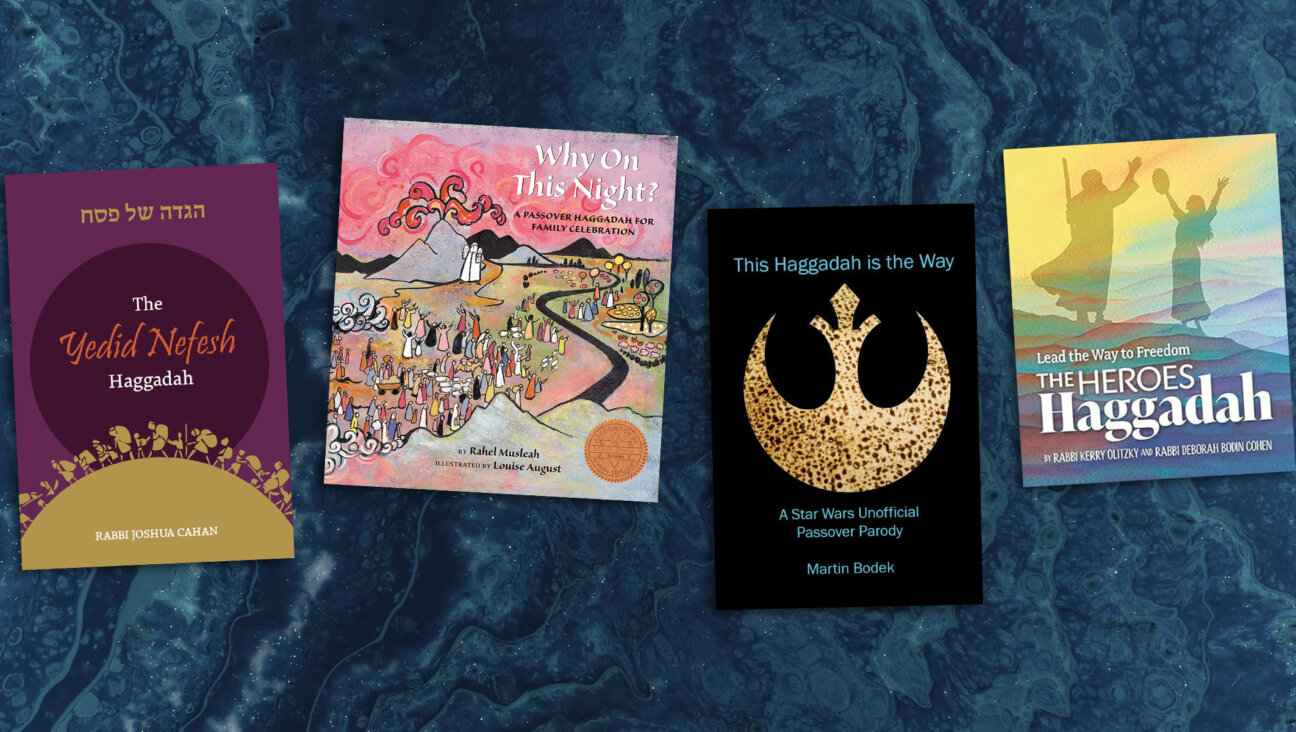Upstart Wineries Drench Previously Arid Country
As the war battered the prime vineyards of Israel’s cool, hilly north in Lebanon last month, Micha Vaadia, the Galil Mountain winemaker, found himself defying the army’s curfew and donning a helmet and flak jacket to inspect the growing ripeness of his grapes. His fruit survived intact, but a Lower Galilee winery, Dalton, ended up sacrificing a few lines of its vineyards to Hezbollah missiles.
While the (now very promising) 2006 Israeli vintage faced such existential threats, and perhaps as evidence of the wine industry’s robustness, two vastly different English-language publications on Israeli wine appeared on bookshelves. The first, by Yaron Goldfisher and Eliezer Sacks, is “The Wine Route of Israel” (Cordinata Publishing House), a glossy coffee-table production re-mapping the entire country according to terroirs (areas of wine cultivation) and wineries — clearly aimed at a reading public of niche-wine devotees or tourists thirsting for something off the beaten track.
The second is Ha’aretz wine critic Daniel Rogov’s “Rogov’s Guide to Israeli Wines” (The Toby Press), a small, beautifully designed, sober and rather scholarly list of every wine produced in the country — every winery and every region — now ubiquitous judging by the growing number of Israeli wine refrigerators.
But back to the harvest, specifically, to the night harvests, which are common in sun-baked lands. It is chilly and very dark at 2:30 a.m. in early September on an elevated ridge in Tel Arad, in the northern Negev. A strange machine — part combine, part spider — rumbles its way along the neat rows of Carignan vines, and a general feeling of ecstasy bursts into the clear air, amid the bright lights aimed down at the furrows, and the twinkling stars — and there is something else: the inimitable scent of meat being grilled. It is the last night of harvest for the Yatir Winery, and one of its employees, originally from Uruguay, has imposed the celebratory traditions of his native land. So no one has drunk a drop, but exuberance fizzes.
Ya’acov Ben Dor, the firm’s CEO, is an Israeli stereotype, perhaps an anachronism: Wearing his knitted skullcap, he refers to himself as a farmer and, at 44, is bright, muscled and determined. He presides over one of the new Israeli economy’s stars, an audacious, roguish winery that released its first wines in the 2001 vintage and has since sprinted to the top rung of Israeli wineries without so much as a glance back at the grand old men of the industry. (It is currently listed at number five of Rogov’s top 10.)
Among other things, the current wine boom under way in Israel has changed what “grand old men” means. Are the grand old men the farmers of 3,000 years ago, whose wine presses are found scattered all over the local “new world” terroirs? (In Yatir’s 200 hectares, 180 ancient presses have been located. About five years ago, the Antiquities Authority forced a Judean Plains winery, Ella Valley, to stop work on its new vineyards when an immense, perfect, round Roman-era press emerged from the crumbly soil.)
For many, the grand old men are the old-style kosher vintners of yesteryear, exemplified by Israel’s former quasi-monopoly, Carmel Mizrahi, once known for its heavy Passover-style, opaque red wines. Still kosher, Carmel Mizrahi remains Israel’s largest producer of wine, only now it releases not a single “yayin mevushal” — the pasteurized wines held in sneering contempt by wine lovers — and among other things, it is part owner of the renegade Yatir Winery.
The newest grand old men were until barely a blink ago Israel’s growling young cubs — for example, Israel’s first boutique winery, the Lower Galilee Margalit, or the Judean Heights Castel wines or the most representative, the Golan Heights Winery, located in Katzrin. Each of these wineries — the oldest, at the ripe old age of 22, is Golan Heights — was considered impudent in its day: Castel for the oft-stated aspirations of its owner, Egyptian-born Eli Ben Zaken, to create local varietal wines that could rival those of France; Margalit for Yair Margalit’s objective of creating a bold, age-worthy Israeli red, and Golan Heights for its preposterous ambition of establishing on the rocky, volcanic soil of a newly acquired cliff a leading-edge, world-class, state-of-the-art California-style, terroir-driven boutique winery. A what? Where?
Its very origins were cosmopolitan: In 1972, Cornelius Ough, professor of viticulture and oenology at the University of California, Davis, visited Israel and determined that Golan land seemed perfect for the cultivation of wine grapes. The first were planted in 1976; the first vintage was released in 1983. And the upstart Golan Heights Winery is now comfortably ensconced not only at its home in the Golan’s capital of Katzrin, where it boasts a must-see visitor’s center and tasting room, but also on the list of top Israeli wines that consistently bring home international wine medals. (It is, once again, number one of Rogov’s top 10.)
Like Americans, Israelis now consume an average of 8 liters of wine per capita per year, lagging far behind the French and Italian 56 and 49 liters, respectively, but about double the figure that held steady until a decade ago. Ya’acov Ben Dor, of the Yatir Winery, speaking entirely seriously, describes the increase in quasi-biblical language as the “rightful recovery of an ancient Jewish tradition to its own roots and people.”
Shmulik Cohen, owner of one of the two largest wine shop chains in Jerusalem, says that Israelis are not only drinking more but also drinking better, if rather conventionally. “After a few years of a herdlike preference for only reds, we’re seeing a trend back to whites and rosés this year, especially the very natural, barely aged whites,” he said, “but this is part of an international phenomenon, following talk of the French paradox.”
Asked to choose a single wine emblematic of 2006, he chooses the Binyamina Winery’s Avnei Hachoshen 2004 Sauvignon Blanc Fumé, which he termed “amazing” and which was one of the summer’s crisp, easy-to-drink hits. Wine itself is such a hit that INFO-Mishekenot Sha’ananim, a Jerusalem forum for international media, has initiated a series of briefings on wine.
Yatir produces only blends, defiantly changing every year, according to the taste and decision of its extravagantly free winemaker, Eran Goldwasser. It is an attitude both retro and brazen: After years of increasing tendencies toward pure varietal wines, Yatir offers a contemporary return to the blended style of traditional Bordeaux.
The diversity of wines now available in Israel — blends and varietals, traditional plantations and wacky strains like Malbec, which has materialized this year — and the refinement of individual winemakers’ assertions are sometimes exposed even on a tiny scale. Castel, Eli Ben-Zaken’s Judean Hills winery (number two on Rogov’s list), is only 10 minutes away from Flam (number three), the winery owned by Golan, Gilad and Israel Flam, two sons and a father who released their first wines in 1998. Ben-Zaken, whose winery is itself a Tuscan-style jewel, speaks of “control” and “expression” when speaking of his grapes, all hand-picked. He produces a Bordeaux-style Grand Vin (Cabernet Sauvignon), a Petit Castel and a fine, noble chardonnay so popular that it is almost impossible to buy. (He sells futures.) The Flams, whose winery now includes a small gastronomic emporium and a restaurant overflowing with Saturday visitors, extract from the same land brash, tingling, new-world cabernet sauvignons and merlots. Visiting both wineries, it is impossible not to recall the original inspiration for Israel itself, that of an Old-New Land growing from the fertile earth.
Noga Tarnopolsky is a cultural correspondent and has been writing about Israeli food and wine for more than 10 years. She guides tours of Israeli gastronomic sites and boutique wineries.
















